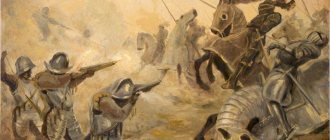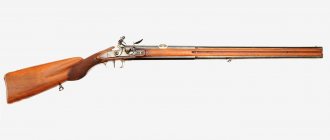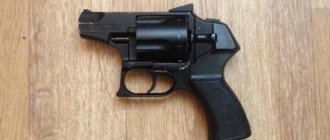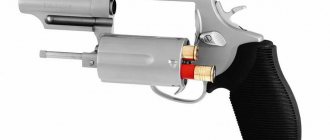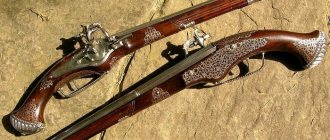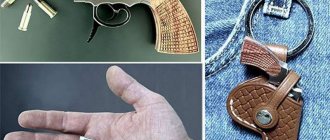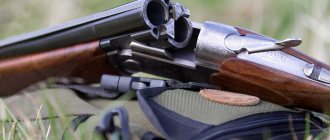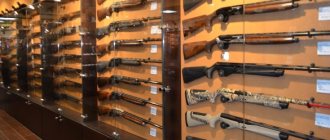Firearms in Rus'. As you know, gunpowder was invented by the Chinese. And not only because they were a developed nation, but also because saltpeter in China lay literally on the surface. Having mixed it with sulfur and charcoal in the 6th century, the Chinese used gunpowder for fireworks, and in military affairs - in throwing bombs.
Later they began to use bamboo cannons, which were enough for 1-2 shots.
In the 13th century, gunpowder was brought to the Middle East by the conquerors - the Mongols. From there, gunpowder, or rather, the idea of gunpowder and firearms came to Europe. Why was artillery born among the Europeans?
The answer is simple: they had traditionally developed metallurgy. Appearing for the first time in Northern Italy at the beginning of the 14th century, firearms spread throughout Europe in the 1340-1370s.
It was then that it appeared in Rus', as chronicled sources say. In 1376, the Moscow-Nizhny Novgorod army of the governor Bobrok-Volynets, the future hero of the Kulikovo field, marches on the Volga Bulgars.
Their enemy brought camels onto the battlefield, hoping that these animals would scare the Russian horses, and the defenders let out “thunders” from the walls of the city of Bulgar. But neither camels nor “thunders” frightened the Russians...
Around 1380, in Moscow, “the first person to make fire-fighting equipment—handles and self-propelled guns, and iron and copper beaks—was a German named Jan.” Muscovites successfully used this weapon during the siege of the city by Tokhtamysh in 1382.
Tokhtamysh entered the city only thanks to deception, promising not to touch the inhabitants, for which the latter paid bitterly. Tokhtamysh's troops burned and plundered Moscow, killing 24,000 people there.
Subsequently, the first samples of firearms, regardless of their purpose, were completely identical and were forged iron and copper barrels, differing only in size.
This is a “handbrake” 30 centimeters long, weighing 4–7 kilograms, a weapon
– “bombard”, in Rus' – “gun”, or “puskich” (from the word let), “mattress” (from the Iranian “tyufeng”).
In the East it is a gun, in our country it is a type of weapon.
And “squeaks” (“pipes”) - both hand weapons and long-barreled guns.
The trend in the development of hand weapons - be it a pistol, arquebus, musket or arquebus - was to lengthen the barrel, improve gunpowder (from poor quality “chaff” gunpowder they switched to “grain” gunpowder, which gives better combustion). The seed hole was moved to the side, and a shelf was made for gunpowder.
Gunpowder in flasks
Typically, gunpowder contained about 60 percent saltpeter and up to 20 percent sulfur and charcoal - although, in terms of proportions, there were many variations. Fundamentally important, however, was only saltpeter.
Popular articles: Charles Spencer Chaplin - Actor and Communist from England
Sulfur was added for ignition - it itself ignited at a very low temperature, coal was only fuel.
Sometimes sulfur was not put into the gunpowder at all - this just meant that the ignition hole would have to be made wider. Sometimes sulfur was not mixed into the gunpowder, but poured directly onto the shelf.
Charcoal could be replaced by ground brown coal, dried sawdust, cornflowers (blue gunpowder), cotton wool (white gunpowder), petroleum (Greek fire), etc.
All this, however, was rarely done, since charcoal was available and there was little point in replacing it with anything else. So any mixture of saltpeter (an oxidizing agent) with some kind of flammable substance should definitely be considered gunpowder.
Initially, gunpowder (literally “dust”) was a fine powder, “pulp”, consisting, in addition to the listed ingredients, of all kinds of debris. When fired, at least half of the gunpowder flew out of the barrel unburnt.
Iron buckshot or stones were sometimes used as projectiles for hand weapons, but most often a round lead bullet was used.
It was round, of course, only immediately after production; the soft lead was deformed during storage, then it was flattened with a ramrod when loading, then the bullet was deformed when fired - in general, after flying out of the barrel, it was no longer particularly round.
The irregular shape of the projectile had a bad effect on shooting accuracy.
Varieties
Gunpowder has long been used not only in military affairs. At one time, they managed to appreciate its benefits in other areas, including hunting. Hunters should be very familiar with what types of gunpowder to use and which gunpowder is best for hunting in certain conditions.
Smoky
The history of gunpowder began with the creation of black gunpowder, and other types of gunpowder were invented much later.
The substance has a granular structure. The grain size affects the quality of the mixture, which determines the speed and force of the bullet.
Depending on the size of the fraction, the mixture receives a number in ascending order from the largest to the smallest:
- large (0.8 – 1.25 mm);
- medium (0.6 – 0.75 mm);
- small (0.4 – 0.6 mm);
- very small (0.25 – 0.4 mm).
To determine quality, you can be guided by certain characteristics. Black powder should be a uniform black or slightly brown color, without inclusions of foreign shades. The fractions are distinguished by a polished surface and the absence of a whitish coating or foreign impurities. If you gently crush the grain between your fingers, it does not crumble, but only splits into several separate particles.
If black powder is poured, it should not form lumps or leave dust during the process. Otherwise, its use can be dangerous for the hunter himself: the dust ignites much faster than the bulk of the mixture, and can provoke an explosion in the barrel of the gun, damaging it.
Among the advantages it should be noted:
- long-term storage without loss of properties if the humidity regime is observed;
- low cost compared to other types;
- rapid flammability, even if the cartridge has a weak primer;
- weak dependence on the quality of wads, rolling, charging density;
- poor sensitivity to temperature changes;
- low impact of powder gases on the barrel.
Of course, there are also disadvantages:
- complete loss of properties when wet;
- contamination of the weapon barrel with carbon deposits;
- thick smoke when fired;
- impossibility of use in semi-automatic weapons;
- relatively low shot flight speed;
- reports strong recoil when fired and accompanies it with a loud sound.
The substance is highly flammable, and combustion of a large mass provokes a powerful explosion. In terms of impact, the smoky one is approximately three times inferior to its smokeless counterpart.
Smokeless
This variety was invented much later than its older “colleague in arms.” At the same time, smokeless powder, also known as colloidal, differs significantly from smoky powder in its properties, composition and characteristics, and has its own advantages and disadvantages of use.
In the hunting environment, it is customary to use the pyroxylin variety of colloidal substance. Nitroglycerin varieties are occasionally used, but they are not very popular.
Smokeless gunpowder is obtained by treating pyroxylin with an oxidizing agent based on an alcohol-ether mixture. The net result is a homogeneous jelly-like substance. The resulting mixture is subjected to mechanical processing, resulting in a granular structure of the substance.
Color can vary from yellow-brown to completely black. At the same time, within one batch, an extraordinary shade of the mixture is acceptable. To obtain a more uniform color, the graphitization process is used - treatment with powdered graphite, which also eliminates the sticking of grains.
- insolubility in water, low hygroscopicity;
- cleaner and more effective than its smoky counterpart;
- When dampened, it does not lose its properties completely;
- when dry, it completely restores its properties, can be dried at temperatures up to 34°C;
- no smoke when fired;
- relatively quiet sound of a shot.
- vapors contain carbon monoxide, which is dangerous to humans;
- negative reaction to temperature fluctuations;
- faster wear of the weapon due to the high temperature inside the barrel;
- the need for sealed storage under certain conditions, otherwise weathering occurs;
- limited shelf life;
- very high combustion temperature, ignition without explosion - danger of fires;
- cannot be used in guns whose passport prohibits its use.
Wheel lock
In the 15th century, the matchlock and then the wheel lock were invented in Europe, and the flintlock was invented in Asia during the same period.
Arquebuses appeared in the regular troops - weapons weighing about three kilograms, a caliber of 13–18 millimeters and a barrel length of 30–50 calibers.
Typically, a 16 mm arquebus fired a 20 gram bullet with an initial speed of about 300 m/s.
The range of aimed fire was 20–25 meters, salvo fire - up to 120 meters. The rate of fire at the end of the 15th – beginning of the 16th century did not exceed one shot per 3 minutes, but the armor penetrated already 25 meters.
Heavier and more powerful arquebuses were already used with a bipod, but there were very few of them - gunpowder in the form of pulp was completely unsuitable for quickly loading long barrels - the hour of muskets had not yet struck.
In Rus', rifled squeaks appeared - fittings. Later, the development of metallurgy made it possible to move on to casting bronze and cast iron cannons.
In the 15th century, it was too early to talk about the mass production of firearms. This did not happen anywhere - neither in Europe nor in Rus'. The number of soldiers armed with firearms in the most advanced armies did not exceed 10 percent.
The point here is not only in its imperfection - try shooting a matchlock from a horse, but cavalry was the main branch of the army - but also in the neglect of firearms on the part of knighthood.
Popular articles: History and secrets of the Russian Luftwaffe
For a noble gentleman, proud of his armor and training, it was shameful to hit the enemy from afar, not in an open, equal battle. And it was a shame to die at the hands of some low commoner, who then not only did not dare to speak to him, but even to raise his eyes to him.
Therefore, knights often cut off the hands and gouged out the eyes of captured arquebusiers, and hung gunners on gun barrels or shot them from their own cannons. Martin Luther even declared guns and gunpowder to be the incarnation of hell.
In Rus', where the power of the sovereign - “God’s anointed” - has always had a sacred character, it was different:
“As the Grand Duke-Father commanded, so be it!”
The development of firearms immediately began on a massive scale with the support of the state, which established the Cannon Yard in Moscow in the 70s of the 15th century, then the Powder Yard, foundries and saltpeter factories, gunpowder mills, and mines.
The Russian army in the 16th century was the most equipped in artillery - then it was called “outfit”.
Its number was measured in hundreds and thousands of guns, amazing foreigners. The Englishman Fletcher saw in the Kremlin at the end of the 16th century many heavy, long-range, richly decorated cannons - “arquelas”, which had their own names - “Lion”, “Unicorn”...
The same “Tsar Cannon” was a combat weapon, not an ostentatious one, capable of firing shot from a machine or simply from the ground.
In the 16th century, master Andrei Chokhov made a “magpie,” called an “organ” in the West, a multi-barrel installation of forty barrels.
This “medieval machine gun” produced a large burst of fire, but was very difficult to load.
A steel rifled arquebus and a bronze rifled cannon, now stored in the Artillery Museum in St. Petersburg, date back to the mid-17th century. Here the Russians were undoubtedly pioneers.
Compared to the arquebus, the Russian arquebus was a powerful weapon: weighing about 8 kilograms, it had a barrel with a caliber of 18–20 millimeters and a length of about 40 calibers.
The charge of gunpowder was solid, so that the armor was penetrated at a distance three times greater than from an arquebus. Like most arquebuses, there were no sights.
Probably, salvo fire could be fired up to 200 meters, however, Russian regulations only provided for firing at a distance of no more than 50 meters. Due to its large weight, the squeak was necessarily provided with a support in the form of a reed.
Thousands of Russian pikas were exported to Iran, about which the Turks repeatedly protested. Loading the arquebus with powder pulp was not easy.
Naturally, handguns increased the role of infantry. Already at the beginning of the 16th century, foot and horse squeakers were recruited from the cities for war, obliged to march with their gunpowder, bullets, provisions and horses.
Popular articles: Soviet Baltic states
For townspeople who were not trained in combat and did not have armor, the arquebus was the most suitable weapon.
Pskov alone, which had up to six thousand households, exhibited up to a thousand squeakers! But these duties ruined the cities, which led to riots. In 1550, Ivan the Terrible, by his decree, established a permanent Streltsy army, maintained at public expense. This is practically the birth date of the Russian regular army.
As for the cavalry, “fire combat” was introduced slowly. At the Serpukhov Noble Review in 1556, about 500 well-armed armored horsemen performed, and only some last battle serf had a arquebus - he, the poor guy, probably didn’t get anything else. The cavalry, being still the main branch of the army, neglected the “weapons of the smerds.”
With the development of firearms came changes in tactics. Samopal for a long time could not compete with the bow until the invention of locks - wheel and flint-percussion, which gave rise to the saddle pistol and carbine.
In the 16th century, German reiters appeared in Europe - mounted “pistoliers”, who utterly destroyed the brilliant French knights. They had pistols in their belts, in their belts, as well as a couple more in their boots.
They drove up to the enemy in rows, shot and drove back behind the last row to reload their weapons.
This method was called "caracole", or "snail". For foot musketeers, this tactic of shooting while leaving the formation was called “limakon”. In battle, they were protected from the cavalry by rows of pikemen - the most defenseless branch of the army, because the reiters shot them with impunity.
The Russian archers followed approximately the same tactics. But each archer carried with him, in addition to a squeak or a musket, also a reed.
The reeds were different: with blades about 50–80 centimeters, and with huge ones, one and a half meters long. In Russia, infantry pikes appeared only in the “regiments of the new system” in the 17th century.
The Russians often fought with a convoy of convoys in a circle, as well as in “walking cities” – defensive structures on wheels, the forerunners of tanks. There were even “ghoul governors”.
At the end of the 16th century, horse-drawn “self-propelled men” appeared in the Russian army, and from the 30s of the 17th century - regular reiters, who, like oh, that is, the noble militia. From now on, service in the reiters becomes honorable. Gradually, pistols were introduced into the noble cavalry...
What came of it all is well known.
The ever-evolving firearm is still the number one "personal defense item."

